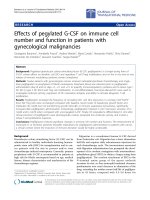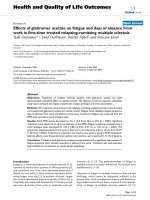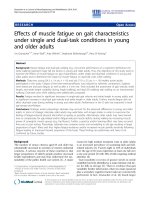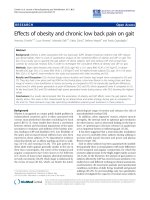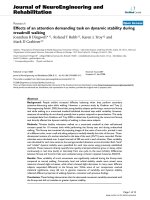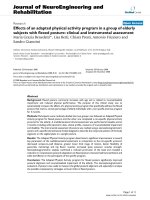Báo cáo hóa học: " Effects of Gas Composition on Highly Efficient Surface Modification of Multi-Walled Carbon Nanotubes by Cation Treatment" pptx
Bạn đang xem bản rút gọn của tài liệu. Xem và tải ngay bản đầy đủ của tài liệu tại đây (354.7 KB, 6 trang )
NANO EXPRESS
Effects of Gas Composition on Highly Efficient Surface
Modification of Multi-Walled Carbon Nanotubes by Cation
Treatment
Wen-Shou Tseng Æ Chyuan-Yow Tseng Æ
Cheng-Tzu Kuo
Received: 24 October 2008 / Accepted: 2 December 2008 / Published online: 16 December 2008
Ó to the authors 2008
Abstract High incident energy hydrogen and/or oxygen
cations are generated by electron cyclotron resonance
system, and then used to highly efficiently modify multi-
walled carbon nanotubes (MWCNTs). The effects of var-
ious H
2
/O
2
gas compositions on the modification process
are studied. A systematic characterization method utilizing
a combination of X-ray photoelectron spectroscopy (XPS),
scanning electron microscopy, Raman spectroscopy, and
thermogravimetric analysis (TGA) is used to evaluate the
effects of various H
2
/O
2
gas compositions on MWCNT
functionalization. The Raman results show that the I
D
/I
G
ratio is directly affected by H
2
concentration in gas mix-
ture, and the treatment applying a H
2
/O
2
gas mixture with
ratio of 40/10 (sccm/sccm) can yield the nanotubes with the
highest I
D
/I
G
ratio (1.27). The XPS results suggest that the
gas mixture with ratio of 25/25 (sccm/sccm) is most
effective in introducing oxygen-containing functional
groups and reducing amorphous carbon. The TGA suggests
that the structural change of the treated nanotubes is mar-
ginal by this method with any gas condition.
Keywords Multi-walled carbon nanotubes Á
Electron cyclotron resonance plasma Á
X-ray photoelectron spectroscopy Á Functionalization Á
Raman spectroscopy
Introduction
Recently, nanostructured materials have attracted intensive
attention in many applications because of their unique
properties [1–4]. As one of the most promising materials,
and to make the best use of their singular properties, carbon
nanotubes (CNTs) can be modified or prepared by different
processes to meet the requirements of specifically potential
applications [5–7]. The process of facially modifying the
nanotubes through changing their surface structure is a
relatively simple technique and has been widely investi-
gated [8–10]. The main premise behind these methods is to
affix highly polar functional groups to the surface of the
nanotubes to enhance their polarity so as to disperse them
in the aqueous or polymer matrix. Currently, acid treatment
is the most commonly used technique for this process.
However, it is mentioned that the use of harsh acids would
give rise to issues concerning the drastic changes of the
structural integrity, length, and even useful properties of
the nanotubes [11–15].
Recently, plasma treatment has been proven to be an
attractive alternative and has become increasingly popular
in the functionalization of CNTs because the procedure is
solvent-free, time-efficient, versatile, and environmental
friendly [16–23]. To date, many approaches have been
investigated to demonstrate the viability and performance
of plasma treatment for surface functionalization of CNTs.
In these studies, various gases, such as N
2
[17], H
2
[18], O
2
[19–21], NH
3
[16, 19, 20], and CF
4
[19, 23] have been
used. Generally, the plasma is generated using glow dis-
charge, radio frequency discharge, or microwave discharge
W S. Tseng
Department of Materials Science and Engineering,
National Chiao Tung University, HsinChu, Taiwan
C Y. Tseng
Department of Vehicle Engineering, National Pingtung
University of Science and Technology, Neipu, Pingtung, Taiwan
C T. Kuo (&)
Institute of Materials and Systems Engineering,
MingDao University, ChangHua, Taiwan
e-mail:
123
Nanoscale Res Lett (2009) 4:234–239
DOI 10.1007/s11671-008-9231-4
at low-vacuum pressure. The high-energy particles gener-
ated in the plasma can then satisfy the chemical bonding
energies on the surface of the tubes thereby initiating
chemical reactions. In addition, their density and energy
can be readily regulated by external parameters, such as the
electromagnetic frequency, power, and gas pressure, to
achieve optimum conditions for the required production
scale and efficiency [16]. However, some studies mention
that the nanotubes could be overheated by hyperthermal
plasma [19, 21].
In our previous study, through using H
2
/O
2
gas mixture
as etching gas, electron cyclotron resonance (ECR) plasma
treatment was shown effective to functionalize multi-wal-
led carbon nanotubes (MWCNTs) with minor negative
consequences in nanotube structure [24]. In the process,
high incident energy hydrogen and oxygen cations gener-
ated and extracted by ECR plasma system were used to
create free radical defects on the surface of the MWCNTs
through ion bombardment; oxygen cations with the high
reduction potential present in the ion stream were simul-
taneously involved in initiating covalent bonding reactions
on the surface of the tubes. The ratio of H
2
to O
2
is critical
to the process because it directly correlates with the com-
position of the generated cations. In this study, the effect of
gas composition on the functionalization process is inves-
tigated, by providing various H
2
/O
2
gas mixtures to the
treatment through the control of gas flow ratio. Further-
more, the manner in which the gas conditions correlate
with morphology and structural changes of the nanotubes
will be studied through the use of some advanced
instruments.
Experimental
Samples of pristine MWCNTs weighing 0.05 g sourced
from a commercial organization were loaded into the
stainless steel crucible and placed on the process stage of
the ECR plasma system as shown in Fig. 1. Chamber
pressure was maintained at 4.2 9 10
-3
Torr. The 2.45 GHz
microwave with output power of approximately 750 W was
inserted into the plasma chamber through a quartz window.
H
2
and/or O
2
gas mixtures were fed as etching gases with
controlled gas flow ratios of 50/0, 40/10, 25/25, 10/40, and
0/50 (H
2
/O
2
(sccm/sccm)), which are equivalent to H
2
concentrations of 100, 80, 50, 20, and 0 vol.%, respectively.
A bias voltage of -250 V was applied to the process stage.
When the stage temperature reached 400 °C, each sample
was treated for 5 min. The ionic current was monitored
using a current ammeter connected to the process stage.
In order to evaluate the surface morphology and structural
changes, the samples were dispersed on a silicon wafer using
ethanol and measured using scanning electron microscopy
(SEM) (JEOL, JSM-6500F). The microstructure of the
pristine sample was characterized by transmission electron
microscopy (TEM) (JEOL, JEM-2100) through dispersing
sample powders on Lacey carbon grids using ethanol. X-ray
photoelectron spectroscopy (XPS) was performed to deter-
mine the chemical changes at the surface of the nanotubes.
Thermogravimetric analysis (TGA) (TA-500) was applied to
investigate the changes in thermal stability with a heating
rate of 10 °C/min and an air flow of 60 mL/min. Raman
spectroscopy (Jobin YVON LabRam HR800) was used to
evaluate structural defects in the CNTs.
Results and Discussion
As shown in Fig. 2, the SEM (Fig. 2a) and TEM (Fig. 2b)
images show that the pristine MWCNTs are highly tangled
with diameters ranging from 15 to 40 nm. The TEM image
(Fig. 2b) also shows that the nanotubes are with densely
distributed defects. After the ECR plasma treatment with a
H
2
/O
2
ratio of 40/10 (sccm/sccm), as depicted in Fig. 2c, d,
the morphologies, structural and the diameter distributions
of the sample do not show any observable difference in
comparison with those of the pristine sample. In contrast to
Fig. 2b, the TEM image in Fig. 2d shows that the disper-
sion ability of the nanotubes is increased after the plasma
treatment so that the nanotube bundle can be significantly
separated. Meanwhile, the insignificant change in mor-
phology and structure can also be observed when sample is
treated with any gas condition.
Figure 3 shows the XPS survey spectra of the untreated
and the ECR-plasma-treated MWCNTs. It is noted that the
spectra showing the presence of carbon and oxygen on the
treated and untreated samples are normalized with respect
Fig. 1 Schematic of the ECR plasma apparatus
Nanoscale Res Lett (2009) 4:234–239 235
123
to C 1s intensity for comparison purposes. In contrast to the
spectrum of the pristine MWCNTs, a higher concentration
of oxygen is introduced to the surface of the nanotubes
treated by the ECR plasma using any gas composition.
As a reference spectrum, the XPS C 1s spectrum of the
pristine MWCNTs was recorded and is shown in Fig. 4.
Based on the previous studies [19, 25], the spectra are
deconvoluted into five Gaussian peaks centered at 284.5,
285.1, 286.2, 287.2, and 288.9 eV. Here, the main peak at
284.5 eV originates from a graphite signal. The peak at
285.1 eV is attributed to sp
3
carbon [19–21, 25]. The peaks
at 286.2, 287.2, and 288.9 eV correspond to hydroxyl,
carbonyl (or ether), and carboxyl (or ester) groups,
respectively. A peak attributed to p–p* shake-up bonds is
observed at 290.4 eV [20, 26]; and the peak at 283.2 eV
originates from carbidic carbon [27]. Meanwhile, the
deconvolution results also show that the oxygen functional
groups have been grafted onto the surface of the pristine
MWCNTs with a concentration of approximately 11.2%.
This is consistent with the description provided by the
vendor that the raw materials were treated using mild acids
prior to shipment. Furthermore, the results show that the
MWCNTs are still composed of approximately 40%
amorphous carbon.
For a detailed comparison, all C 1s spectra of the
MWCNT samples are presented in Fig. 5 and the calculated
results are summarized in Table 1. Note that the [O]/[C] ratio
given in Table 1 is based on the relative percentage of three
carboxyl groups to the total number of carbon atoms detec-
ted. As shown in Fig. 5 and Table 1, after the samples are
treated by the plasma treatment, the XPS measurements
show that the concentrations of the graphite, sp
3
carbons, and
oxygen-containing functional groups are different accord-
ing to the gas mixture composition. Also, it is clear that
when the samples of the MWCNTs are treated with a H
2
/O
2
ratio of 25/25 (sccm/sccm), the highest concentration of
Fig. 2 a SEM and b TEM
images of the pristine
MWCNTs, c SEM, and d TEM
images of ECR-plasma-treated
MWCNTs with 5 min exposure
under H
2
/O
2
gas compositions
of 40/10 (sccm/sccm)
Fig. 3 XPS survey spectra of the pristine MWCNTs and the ECR-
plasma-treated MWCNTs under various H
2
/O
2
(sccm/sccm) gas
compositions
Fig. 4 XPS C 1s spectra of the pristine MWCNTs and the five
chemical species: (1) graphite; (2) sp
3
carbons; (3) hydroxyl groups;
(4) carbonyl groups; and (5) carboxyl groups
236 Nanoscale Res Lett (2009) 4:234–239
123
oxygenated functional groups is achieved whilst the con-
centration of amorphous carbon is minimized.
Note that the amount of surface defects is important for
functional groups to form on the nanotube surface [10]. In
order to evaluate the formation of defects on the nanotube
surface by the ECR plasma treatment using different gas
compositions, the Raman spectra of the pristine and the
plasma-treated MWCNTs are presented in Fig. 6. Two
characteristic peaks are observed and attributed to the D
and G bands. The spectra have been normalized with
respect to the G band for comparison. The intensity of the
D band, at frequencies around 1,344 cm
-1
, is correlated
with structural disorder of CNTs, which originates from the
defects including disordered materials, poor graphitization,
functionalized carbon, and the amorphous carbon on the
sidewall of nanotubes [28–30]. The G band at frequencies
around 1,572 cm
-1
is activated by the graphite signal [30].
It is suggested that the I
D
/I
G
ratio is closely associated with
the defect density on the walls of the MWCNTs [30].
Therefore, the intensity ratio can be used to evaluate the
formation of defects which are preferential sites for
functionalization.
As expected, all I
D
/I
G
ratios are increased after plasma
treatment with any gas composition. As shown in the inset
of Fig. 6, the I
D
/I
G
ratio increases from 1.03 to 1.27 when
the H
2
concentration increases from 0 to 80 vol.%. Note
that the ion density is very important for surface etching.
By comparing the ionic current, it is found that current
increases from 0.12 to 0.47 A while the H
2
concentration
increases from 0 to 100%. This shows that the ion density
of the cation stream increases as H
2
concentration increa-
ses. This leads to higher I
D
/I
G
ratio when H
2
concentration
of the etching gas is higher. However, it is also shown that
the ratio decreases to 1.08 when the nanotubes are treated
with pure H
2
gas (H
2
/O
2
of 50/0 (sccm/sccm)). This could
be because the ion bombardment under this gas condition
can heavily etch the surface of the nanotubes to the extent
that the concentration of amorphous carbon coated on the
Fig. 5 XPS C 1s spectra of the pristine MWCNTs and the ECR-
plasma-treated MWCNTs after 5 min of exposure under various H
2
/
O
2
(sccm/sccm) gas compositions
Table 1 The MWCNT specimen treated under various H
2
/O
2
gas compositions; the characterization results of XPS; and the I
D
/I
G
ratio of
Raman spectra
Specimen (H
2
/O
2
(sccm/sccm))
XPS Raman
sp
2
(%) sp
3
(%) –C–O (%) –C=O (%) –COO (%) [O]/[C]
a
(%) (I
D
/I
G
)
0/50 44.2 44.6 \0.1 9.4 1.7 11.1 1.03
10/40 40.5 39.5 11.9 0.8 7.3 20 1.05
25/25 42.8 26.1 13.8 17.3 \0.1 31.1 1.07
40/10 36.8 49.1 0.6 0.5 12.9 14 1.27
50/0 30.8 54 2.1 11 2.2 15.3 1.08
Pristine 48.8 40 1 8.4 1.8 11.2 0.89
a
[O]/[C]: the ratio of oxygenated groups to the total number of carbon atoms detected
Fig. 6 Raman spectra of the pristine MWCNTs and the ECR-plasma-
treated MWCNTs after 5 min of exposure under various H
2
/O
2
(sccm/sccm) gas conditions
Nanoscale Res Lett (2009) 4:234–239 237
123
surface could thus be raised from 40 to 54% as shown in
Table 1. The thick amorphous carbon can prevent defects
from further forming on the surface during ion bombard-
ment so that the I
D
/I
G
ratio is significantly smaller than that
of the nanotubes treated with the etching gas containing
20 vol.% oxygen (I
D
/I
G
= 1.27, H
2
/O
2
of 40/10 (sccm/
sccm)). Apart from their involvement in ion bombardment,
the generated oxygen cations can also act as highly reactive
chemical species which form covalent bonds with the
amorphous carbon and then nanotube surface. More spe-
cifically, the amorphous carbon layer is more reactive than
the cylindrical walls to form volatile products with the
oxygen cations. The products are then pumped out by the
vacuum system. Thus, as shown in Table 1, treatment
using a H
2
/O
2
mixture can increase the concentration of
oxygenated functional groups whilst also reducing the
concentration of amorphous carbon. On the other hand,
treatment with pure O
2
gas (with the exception of
increasing the I
D
/I
G
ratio) does not yield any other obvious
effects in regard to the purity of CNTs and the concen-
tration of functional groups when compared with the
pristine MWCNTs. This indicates that a H
2
/O
2
mixture not
only facilitates defect formation but also promotes covalent
bonding in this case. Therefore, even with the addition of
20 vol.% H
2
(H
2
/O
2
of 10/40 (sccm/sccm)) in gas, there is
still a significant removal of amorphous carbon and for-
mation of oxygen-containing groups on the nanotube
surface.
Figure 7 shows the weight-derivative curves of TGA
analysis on the pristine MWCNT samples and the ECR-
plasma-treated MWCNTs. The results show that with a
decomposition temperature of 600 °C, the pristine MWCNT
samples are the most thermally stable with respect to
oxidative degradation. Correspondingly, the MWCNTs
treated by the ECR plasma with a gas composition of 40/10
(sccm/sccm) have the lowest decomposition temperature
(594 °C). It should be noted that the oxidation stability is a
function of the combined effect of defects and the diameter
of the nanotubes [12, 31, 32]. With the same diameter dis-
tribution, the results are in agreement with the hypothesis
that the decrease of the oxidation reaction temperature is
mainly a result of the defects produced by the plasma
treatment. The marginal differences between untreated and
treated samples reflect the fact that the effect of gas com-
position on structural integrity of the nanotubes is
insignificant in this case.
Conclusions
In this article, the effects of various H
2
/O
2
gas composi-
tions on the functionalization of MWCNTs using ECR
plasma system are studied. The results of Raman spec-
troscopy show that the cation treatment is effective in
introducing defects to the nanotube surface; and this is
affected by H
2
concentration in gas mixture provided.
Meanwhile, with a H
2
/O
2
mixture of 40/10 (sccm/sccm),
the treatment can produce nanotubes with highest I
D
/I
G
ratio (1.27). As demonstrated by the characterization
results of XPS, the gas composition strongly correlates
with the functionalization extent and amorphous carbon
removal. As compared to the other gas composition applied
in this study, the treatment using a H
2
/O
2
mixture of 25/25
(sccm/sccm) is found to be the most effective gas mixture
to graft oxygen-containing functional groups and remove
the amorphous carbon on the surface of the nanotubes.
Specifically, by using this gas condition to conduct the
plasma treatment, the highest concentration of 31.1% (after
5 min exposure) of oxygenated functional groups on the
surface of CNTs is achieved. In addition, the amorphous
carbon can also be significantly removed. On the other
hand, the results also indicate that the structural and mor-
phological changes, if any, are marginally effected by this
method with any gas composition.
References
1. C. Yan, D. Xue, J. Phys. Chem. B 110, 7102 (2006). doi:
10.1021/jp057382l
2. X. Yan, D. Xu, D. Xue, Acta. Mater. 55, 5747 (2007). doi:
10.1016/j.actamat.2007.06.023
3. S.A. Corr, Y.P. Rakovich, Y.K. Gunko, Nanoscale Res. Lett. 3,
87 (2008). doi:10.1007/s11671-008-9122-8
4. F.J. Owens, Nanoscale Res. Lett. 2, 447 (2007)
5. S.K. Srivastava, V.D. Vankar, V. Kumar, V.N. Singh, Nanoscale
Res. Lett. 3, 205 (2008)
Fig. 7 Weight-derivative curves of TGA on the pristine MWCNTs
and the ECR-plasma-treated MWCNTs under various H
2
/O
2
(sccm/
sccm) gas compositions
238 Nanoscale Res Lett (2009) 4:234–239
123
6. B.P. Singh, D. Singh, R.B. Mathur, T.L. Dhami, Nanoscale Res.
Lett. 3, 444 (2008). doi:10.1007/s11671-008-9179-4
7. S. Takeda, M. Nakamura, A. Ishii, A. Subagyo, H. Hosoi,
K. Sueoka, K. Mukasa, Nanoscale Res. Lett. 2, 207 (2007). doi:
10.1007/s11671-007-9053-9
8. K.F. Fu, Y.P. Sun, J. Nanosci. Nanotechnol. 3, 351 (2003). doi:
10.1166/jnn.2003.225
9. E.T. Mickelson, C.B. Huffman, A.G. Rinzler, R.E. Smalley,
R.H. Hauge, J.L. Margrave, Chem. Phys. Lett. 296, 188 (1998).
doi:10.1016/S0009-2614(98)01026-4
10. S. Banerjee, M.G.C. Kahn, S.S. Wong, Chem. Eur. J. 9, 1899
(2003). doi:10.1002/chem.200204618
11. A.R. Harutyunyan, B.K. Pradhan, J.P. Chang, G.G. Chen,
P.C. Eklund, J. Phys. Chem. B 106, 8671 (2002). doi:10.1021/
jp0260301
12. M. Zhang, M. Yudasaka, S. Iijima, J. Phys. Chem. B 108, 149
(2004). doi:10.1021/jp035850q
13. L. Dumitrescu, N.R. Wilson, J.V. Macpherson, J. Phys. Chem. C
111, 12944 (2007). doi:10.1021/jp067256x
14. N.I. Kovtyukhova, T.E. Mallouk, L. Pan, E.C. Dickey, J. Am.
Chem. Soc. 125, 9761 (2003). doi:10.1021/ja0344516
15. J. Zhu, M. Yudasaka, M.F. Zhang, S. Iijima, J. Phys. Chem. B
108, 11317 (2004). doi:10.1021/jp0494032
16. Z.Y. Wu, Y.Y. Xu, X.L. Zhang, G.L. Shen, R.Q. Yu, Talanta 72,
1336 (2007). doi:10.1016/j.talanta.2007.01.052
17. B. Khare, P. Wilhite, B. Tran, E. Teixeira, K. Fresquez,
D.N. Mvondo, C. Bauschlicher, M. Meyyappan, J. Phys. Chem. B
109, 23466 (2005). doi:10.1021/jp0537254
18. A. Hassanien, M. Tokumoto, P. Umek, D. Vrbanic, M. Mozetic,
D. Mihailovic, P. Venturini, S. Pejovnik, Nanotechnology 16, 278
(2005). doi:10.1088/0957-4484/16/2/017
19. A. Felten, C. Bittencourt, J.J. Pireaux, G. Van Lier, J.C. Charlier,
J. Appl. Phys. 98, 074308 (2005). doi:10.1063/1.2071455
20. R. Ionescu, E.H. Espinosa, E. Sotter, E. Llobet, X. Vilanova,
X. Correig, A. Felten, C. Bittencourt, G. Van Lier, J.C. Charlier,
J.J. Pireaux, Sens. Actuators B Chem. 113, 36 (2006). doi:
10.1016/j.snb.2005.02.020
21. T. Xu, J.H. Yang, J.W. Liu, Q. Fu, Appl. Surf. Sci. 253, 8945
(2007). doi:10.1016/j.apsusc.2007.05.028
22. B.N. Khare, P. Wilhite, R.C. Quinn, B. Chen, R.H. Schingler, B.
Tran, H. Imanaka, C.R. So, C.W. Bauschlicher, M. Meyyappan,
J. Phys. Chem. B 108, 8166 (2004). doi:10.1021/jp049359q
23. Y.W. Zhu, F.C. Cheong, T. Yu, X.J. Xu, C.T. Lim, J.T.L. Thong,
Z.X. Shen, C.K. Ong, Y.J. Liu, A.T.S. Wee, C.H. Sow, Carbon
43, 395 (2005). doi:10.1016/j.carbon.2004.09.029
24. W.S. Tseng, C.Y. Tseng, P.K. Chuang, A.Y. Lo, C.T. Kuo,
J. Phys. Chem. C 112, 18431 (2008)
25. H. Ago, T. Kugler, F. Cacialli, W.R. Salaneck, M.S.P. Shaffer,
A.H. Windle, R.H. Friend, J. Phys. Chem. B 103, 8116 (1999).
doi:10.1021/jp991659y
26. Y. Zhang, S.L. Yuan, W.W. Zhou, J.J. Xu, Y. Li, J. Nanosci.
Nanotechnol. 7, 2366 (2007). doi:10.1166/jnn.2007.412
27. A. Wiltner, C. Linsmeier, Phys. Status Solidi A 201, 881 (2004).
doi:10.1002/pssa.200304362
28. M.M. Shaijumon, A.L.M. Reddy, S. Ramaprabhu, Nanoscale
Res. Lett. 2, 75 (2007). doi:10.1007/s11671-006-9033-5
29. A.C. Dillon, M. Yudasaka, M.S. Dresselhaus, J. Nanosci. Nano-
technol. 4, 691 (2004). doi:10.1166/jnn.2004.116
30. S.R. Jian, Y.T. Chen, C.F. Wang, H.C. Wen, W.M. Chiu,
C.S. Yang, Nanoscale Res. Lett. 3, 230 (2008)
31. S.K. Pillai, S.S. Ray, M. Moodley, J. Nanosci. Nanotechnol. 7,
3011 (2007). doi:10.1166/jnn.2007.921
32. Q.F. Liu, W.C. Ren, F. Li, H.T. Cong, H.M. Cheng, J. Phys.
Chem. C 111, 5006 (2007). doi:10.1021/jp068672k
Nanoscale Res Lett (2009) 4:234–239 239
123
